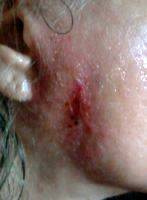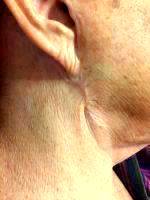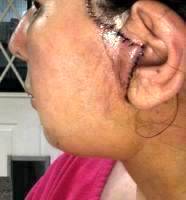Side Effects Of Facelift
Facelift surgery like any other surgical procedures is expected to have some discomfort, swelling and bruising.
These are not considered side affects rather normal process of healing.
The degree of post-operative discomfort, bruising, and also any potential complication such as hematoma or delayed healing depends on the type of facelift and patient’s physiology.
A mini-facelift that is performed with local anesthesia and oral sedation takes a shorter time to perform and has minimal complication.
A full facelift under general anesthesia takes longer to perform and prone to more complications.
Most common complications associated with facelift are as follow:
- Hematoma and seroma
- Prolonged numbness
- Infection
- Delayed healing
Each one of these occurs less than 1% in my practice. In the hands of a Facial Plastic Surgeon who in is a facelift expert, these risks are very rare.

Facelift Complication Photo
Facelift risks
A facelift doesn’t hurt as much as you might think and the recovery not as lengthy as you may believe. There are risks to every operation. Such as bleeding, infection, and nerve injury.
Fortunately, there are rare.
Side Effects Following Facelift
Facelifts are frequently performed cosmetic procedures that are associated with low complication rates. The incidence of complications appears to be related to the aggressiveness of the surgical procedure. When more extensive procedures are performed, a greater incidence of complications can be anticipated.
Although facelifts are considered to be extremely safe, complications may occasionally occur. These include bleeding, hematoma formation, skin discoloration, wound healing problems, wound breakdown, loss of tissue, excess scarring, seroma formation, infection, asymmetry, numbness, facial nerve injury, ear malposition, hair loss, cardiac and pulmonary complications.
Several steps can be taken to minimize complications. These include utilizing an accredited outpatient surgical facility, a board certified plastic surgeon and a board certified anesthesiologist. Although, these steps won’t totally eliminate complications they will hopefully decrease their incidence.

Excess Scarring
Facelift recovery and side effects
In general, it takes about 2 weeks for most of the swelling to subside after a facelift, although some subtle residual swelling can take longer. With any operation, infection, bleeding, and excessive scarring are infrequent complications.
One side effect specific to facelift is the small possibility of a nerve injury causing facial muscle weakness, which fortunately usually fades.
Numbness of the skin of the cheeks in the area around the ears is always present, but this too resolves over several months.
There can also be numbness in other areas depending on the technique used. It is important to ask your surgeon for his or her experience and rate of complication.
Swelling, bruising, and discomfort are the most common side effects from facelift surgery. You may also feel sick to your stomach as a result of the anesthesia, and you may experience mild facial numbness or itchiness for a few weeks.
Remember that these side effects are normal and temporary. More severe complications such as infection, hematoma, or nerve damage are much less common and are unlikely to occur with a skilled surgeon. Make sure your plastic surgeon is certified by the American Board of Plastic Surgery to ensure a smooth procedure.
The normal side effect for patients is swelling. Other side effects include infection, scarring, bleeding, damage to nerves and blood vessels. These side effects are all very infrequent in normal healthy patients.
The three most common face lift side-effects: swelling, worst at 5 days, subsiding slowly over 6 weeks, subtle improvement continues for six months or longer. Bruising. Shows most in thin skinned, light skinned women. Lasts 2-3 weeks.
Numbness – the skin is swollen. Feeling is just plain strange – you feel it but it doesn’t feel normal. This is gone in 6-18 months. In my practice at least, pain lasts a day or two and is from the bandage which I remove in 24 hours.
With modern techniques, results are excellent and healing fast.
Face lift swelling and other risks related to a face lift

Hematoma After Facelift Is Common
There are many risks with a face lift including bleeding, infection, damage to organs, nerves, vessels, scarring, anesthesia, bumps, lumps, etc. Your doctor will go over all the risks or at least have most of them in the consents that you will sign.
Swelling is a part of the healing process. But we have some tips to follow on the swelling.
Facelift Side Effects/Complications
As with any surgery, there are several common side-effects including infection, bleeding, wound breakdown, and scar formation. One specific complication that is potentially devastating in a facelift procedure is facial nerve injury leading to facial paralysis.
A permanent facial nerve injury resulting in a noticeable paralysis roughly occurs at a rate of 1%. There are different types of facelift procedures ranging from skin tightening only to a deep-plane facelift. The rate of injury to the facial nerve is more common in the deep-plane facelift procedures.

Infection After Facelift Photo
Therefore, it is critical if one is contemplating a facelift procedure, to consult with a board-certified plastic surgery and specifically ask what type of facelift would be the best in your specific case. Other side-effects of a facelift include distortion of the earlobe, displacement of the side-burn, scarring along the hairline behind the ear, and numbness around the ear (possibly permanent).
A hematoma in the face is not treated like a hematoma in other types of surgeries. Even a small amount of blood underneath the facelift skin flaps can result in loss of skin, poor cosmetic result, discoloration of the skin, and a lumpy feeling of the skin (even after the hematoma resolves.)
Therefore, minimizing a hematoma after a facelift and expeditious evacuation of the hematoma (commonly in the OR) are essential.

Swelling After Facelift
Undesirable side effect – there out there but can be avoided
You are not the first person that does not want to deal with the issues of – pain, pulled look” , lengthy recovery, need for touch ups, I can go no and on.
If you have the time please look at the videos about the types of face lifts on my web site.
Then go to the before and after pictures. You may find the answers to all of your questions.
Some side effects of a facelift include facial swelling, asymmetry, nerve injuries, sensory changes, skin loss, hematomas, or seromas, contour irregularities, to name a few
Although there are a myriad of complications with any given procedure, including shaving, the most common side effects with a facelift include flap loss, loss of skin, thickened or unsightly scars, nerve injury, and hematoma.
The risk of these complications is relatively low but can be increased in men, by a history of previous surgeries, history of poor scarring, and intake of blood thinners. Discuss these risks and benefits with a board certified plastic surgeon.
Choosing the right person for your Facelift Surgery
The best way to limit your risk of side effects with facelift surgery, is choosing a qualified, board-certified plastic surgeon, certified by the American Board of Plastic Surgery. Facelift sugery can do many things safely, but there are always risk to consider.
Any surgery has risk of bleeding and infection, facelifting is included. There is always the risk of injury to structures in the area or a result you are not happy with, but these risks are unusual.
Your board certified specialist will discuss all of your concerns, but it is vital to share your expectations and desires before surgery, to get the best possible result, safely.

